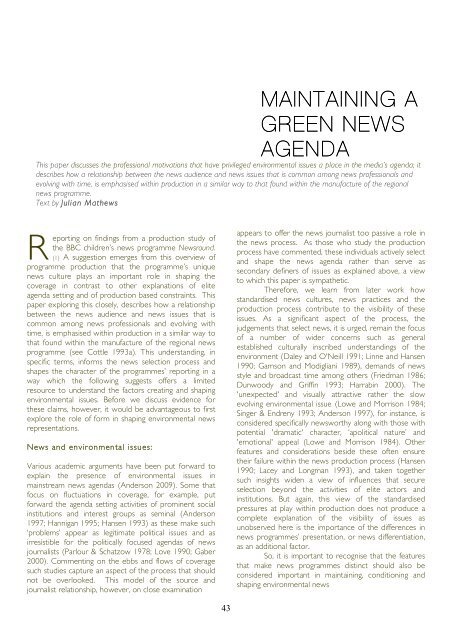M - Antennae The Journal of Nature in Visual Culture
M - Antennae The Journal of Nature in Visual Culture
M - Antennae The Journal of Nature in Visual Culture
Create successful ePaper yourself
Turn your PDF publications into a flip-book with our unique Google optimized e-Paper software.
MAINTAINING A<br />
GREEN NEWS<br />
AGENDA<br />
This paper discusses the pr<strong>of</strong>essional motivations that have privileged environmental issues a place <strong>in</strong> the media’s agenda; it<br />
describes how a relationship between the news audience and news issues that is common among news pr<strong>of</strong>essionals and<br />
evolv<strong>in</strong>g with time, is emphasised with<strong>in</strong> production <strong>in</strong> a similar way to that found with<strong>in</strong> the manufacture <strong>of</strong> the regional<br />
news programme.<br />
Text by Julian Mathews<br />
R<br />
eport<strong>in</strong>g on f<strong>in</strong>d<strong>in</strong>gs from a production study <strong>of</strong><br />
the BBC children’s news programme Newsround.<br />
(1) A suggestion emerges from this overview <strong>of</strong><br />
programme production that the programme’s unique<br />
news culture plays an important role <strong>in</strong> shap<strong>in</strong>g the<br />
coverage <strong>in</strong> contrast to other explanations <strong>of</strong> elite<br />
agenda sett<strong>in</strong>g and <strong>of</strong> production based constra<strong>in</strong>ts. This<br />
paper explor<strong>in</strong>g this closely, describes how a relationship<br />
between the news audience and news issues that is<br />
common among news pr<strong>of</strong>essionals and evolv<strong>in</strong>g with<br />
time, is emphasised with<strong>in</strong> production <strong>in</strong> a similar way to<br />
that found with<strong>in</strong> the manufacture <strong>of</strong> the regional news<br />
programme (see Cottle 1993a). This understand<strong>in</strong>g, <strong>in</strong><br />
specific terms, <strong>in</strong>forms the news selection process and<br />
shapes the character <strong>of</strong> the programmes’ report<strong>in</strong>g <strong>in</strong> a<br />
way which the follow<strong>in</strong>g suggests <strong>of</strong>fers a limited<br />
resource to understand the factors creat<strong>in</strong>g and shap<strong>in</strong>g<br />
environmental issues. Before we discuss evidence for<br />
these claims, however, it would be advantageous to first<br />
explore the role <strong>of</strong> form <strong>in</strong> shap<strong>in</strong>g environmental news<br />
representations.<br />
News and environmental issues:<br />
Various academic arguments have been put forward to<br />
expla<strong>in</strong> the presence <strong>of</strong> environmental issues <strong>in</strong><br />
ma<strong>in</strong>stream news agendas (Anderson 2009). Some that<br />
focus on fluctuations <strong>in</strong> coverage, for example, put<br />
forward the agenda sett<strong>in</strong>g activities <strong>of</strong> prom<strong>in</strong>ent social<br />
<strong>in</strong>stitutions and <strong>in</strong>terest groups as sem<strong>in</strong>al (Anderson<br />
1997; Hannigan 1995; Hansen 1993) as these make such<br />
‘problems’ appear as legitimate political issues and as<br />
irresistible for the politically focused agendas <strong>of</strong> news<br />
journalists (Parlour & Schatzow 1978; Love 1990; Gaber<br />
2000). Comment<strong>in</strong>g on the ebbs and flows <strong>of</strong> coverage<br />
such studies capture an aspect <strong>of</strong> the process that should<br />
not be overlooked. This model <strong>of</strong> the source and<br />
journalist relationship, however, on close exam<strong>in</strong>ation<br />
43<br />
appears to <strong>of</strong>fer the news journalist too passive a role <strong>in</strong><br />
the news process. As those who study the production<br />
process have commented, these <strong>in</strong>dividuals actively select<br />
and shape the news agenda rather than serve as<br />
secondary def<strong>in</strong>ers <strong>of</strong> issues as expla<strong>in</strong>ed above, a view<br />
to which this paper is sympathetic.<br />
<strong>The</strong>refore, we learn from later work how<br />
standardised news cultures, news practices and the<br />
production process contribute to the visibility <strong>of</strong> these<br />
issues. As a significant aspect <strong>of</strong> the process, the<br />
judgements that select news, it is urged, rema<strong>in</strong> the focus<br />
<strong>of</strong> a number <strong>of</strong> wider concerns such as general<br />
established culturally <strong>in</strong>scribed understand<strong>in</strong>gs <strong>of</strong> the<br />
environment (Daley and O'Neill 1991; L<strong>in</strong>ne and Hansen<br />
1990; Gamson and Modigliani 1989), demands <strong>of</strong> news<br />
style and broadcast time among others (Friedman 1986;<br />
Dunwoody and Griff<strong>in</strong> 1993; Harrab<strong>in</strong> 2000). <strong>The</strong><br />
'unexpected' and visually attractive rather the slow<br />
evolv<strong>in</strong>g environmental issue (Lowe and Morrison 1984;<br />
S<strong>in</strong>ger & Endreny 1993; Anderson 1997), for <strong>in</strong>stance, is<br />
considered specifically newsworthy along with those with<br />
potential 'dramatic' character, ‘apolitical nature’ and<br />
'emotional' appeal (Lowe and Morrison 1984). Other<br />
features and considerations beside these <strong>of</strong>ten ensure<br />
their failure with<strong>in</strong> the news production process (Hansen<br />
1990; Lacey and Longman 1993), and taken together<br />
such <strong>in</strong>sights widen a view <strong>of</strong> <strong>in</strong>fluences that secure<br />
selection beyond the activities <strong>of</strong> elite actors and<br />
<strong>in</strong>stitutions. But aga<strong>in</strong>, this view <strong>of</strong> the standardised<br />
pressures at play with<strong>in</strong> production does not produce a<br />
complete explanation <strong>of</strong> the visibility <strong>of</strong> issues as<br />
unobserved here is the importance <strong>of</strong> the differences <strong>in</strong><br />
news programmes’ presentation, or news differentiation,<br />
as an additional factor.<br />
So, it is important to recognise that the features<br />
that make news programmes dist<strong>in</strong>ct should also be<br />
considered important <strong>in</strong> ma<strong>in</strong>ta<strong>in</strong><strong>in</strong>g, condition<strong>in</strong>g and<br />
shap<strong>in</strong>g environmental news












